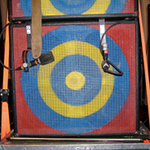“Canceled”: Alternative Manifestations and Productive Failures, which chronicles an idiosyncratic history of terminated art exhibitions and projects whose reputations endure through printed materials, deftly explores critical dynamics of power and authority while generally skirting trite examples of First Amendment flag-waving. With a compact presentation at the Center for Book Arts of catalogues, posters, magazines, booklets, PDFs, and more, the curator Lauren van Haaften-Schick establishes how, over the last fifty-five years, myriad forms of censorship have evolved from swift police ambushes and reactionary political grandstanding to the development of complex legal positions on intellectual property.
Which isn’t to say the older, caustic approaches have disappeared: the removal of David Wojnarowicz's film A Fire in My Belly (1986–87) from the exhibition Hide/Seek made headlines in late 2010, inducing flashbacks of the tumultuous Culture Wars from two decades ago. But more significant to contemporary conversations are two recent legal entanglements regarding ownership of images and art—Patrick Cariou suing Richard Prince and Gagosian Gallery for unlawfully appropriating his photographs, and Mass MoCA and Christoph Büchel battling over the fate of a massive installation, the incongruously titled Training Ground for Democracy, that ran over budget and was left incomplete—that largely disregard what the works actually depict. Documentation from both cases, including Amy Wilson’s watercolors based on photographs of Training Ground and a print-on-demand book containing Prince’s deposition, the most extensive and truthful “interview” the notoriously cagey artist has ever given, alongside other official court documents, doesn’t quite offer a titillating experience. But you’ll get properly schooled on important issues peripheral to quaint concerns about, say, pictures of naked people.
The curator includes famous cases of canceled exhibitions, such as the Guggenheim’s annulment of a Hans Haacke survey in 1971, while others, like Jo Baer’s 1972 refusal to accept a severe downgrade in gallery space at the Whitney, are lesser known. Michael Rakowitz’s letter from 2008, in which he declines an offer to show work at a Chicago museum that had previously caved to donor pressure and closed a show ten weeks early, demonstrates that things haven’t improved. A “lost” Bas Jan Ader film from the 1970s that was posted to YouTube in 2007—later deemed a fake, created by the artist David Horvitz—was flagged and removed due to a vaguely articulated infringement claim. This suggests interesting questions about the status of the bootleg in an age of illegal downloads, as well as who owns the millions of photographs, videos, and songs uploaded to proprietary websites like YouTube and Facebook. Think of all those unread but clicked-through terms of agreement.
It’s not clear why van Haaften-Schick associates the work of Seth Siegelaub, a visionary art dealer from the late 1960s who was among the first to champion the publication as gallery space, with documentation of cancellations, as his “alternative manifestations” of distribution and display helped artists to expand outward without thinking of institutional support as a first resort. Besides, most any show, shut down or not, is experienced in the moment and leaves behind a paper trail of catalogues, press releases, newspaper clippings, and installation photographs. Likewise, her notion of “productive failures” feels trendy, but her point is taken: cancellations are never the last word and often lead to better things. When officials in Cyprus rescinded support for the roving European biennial Manifesta in 2006, participating curators, writers, and artists developed the informal art-education center unitednationsplaza in Berlin and Mexico City, and also Night School in New York, two highly influential projects that anticipated the similarly independent-minded Occupy movement.
